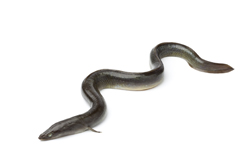The mystery of eels
Catches of yellow and silver eels have declined from 40 000 tonnes in the 1960s to less than 20 000 tonnes today. Until now, scientists have understood little about the ecological processes behind this decline, largely due to technical difficulties in studying eel populations. Researchers working on the EU-funded 'European eels in the Atlantic: Assessment of their decline' (EELIAD) project successfully tracked eels over more than 3 000 km to locations close to the mid-Atlantic ridge. They were able to map the spawning migration routes of European eels, and gained insights into the behaviour of eels during their migration period of more than nine months. The team also identified factors affecting the migratory success of eels, including the previously unobserved phenomenon of coastal and oceanic predation. Studies in Ireland, Spain and France showed that changes in fishing efforts and catchment management have also impacted on eel population dynamics in recent decades. Other research showed that fluctuations in pressure and temperature likely control eel maturation and reproductive cycles. This new knowledge is useful for improving eel aquaculture, which could decrease the pressure on wild stock. EELIAD also provided the first population genetics study of European and American eel larvae sampled at the spawning ground, supplemented by data from European glass eels. The findings suggest that the European eel should be considered a classical example of panmixia (random mating) and should be managed as such. Further data showed that there are uncertainties associated with the current classification and assessment of silver eel status and quality. As such, the EELIAD team worked towards refining silver eel identification protocols and developing non-invasive tests for important diseases. Interestingly, the project's eel-tracking efforts attracted the attention of film makers from Ireland, Spain, France, Sweden, the United Kingdom and the United States. In total, 10 short films were made. According to EELIAD researchers, 'The Mystery of Eelsꞌ provided a powerful story for outreach about the importance of proper eel and eel habitat stewardship. Indeed, the biological and ecological knowledge generated by EELIAD researchers will help define sustainable and justifiable eel management practices. This is important since global eel production is worth over EUR 2 billion.







